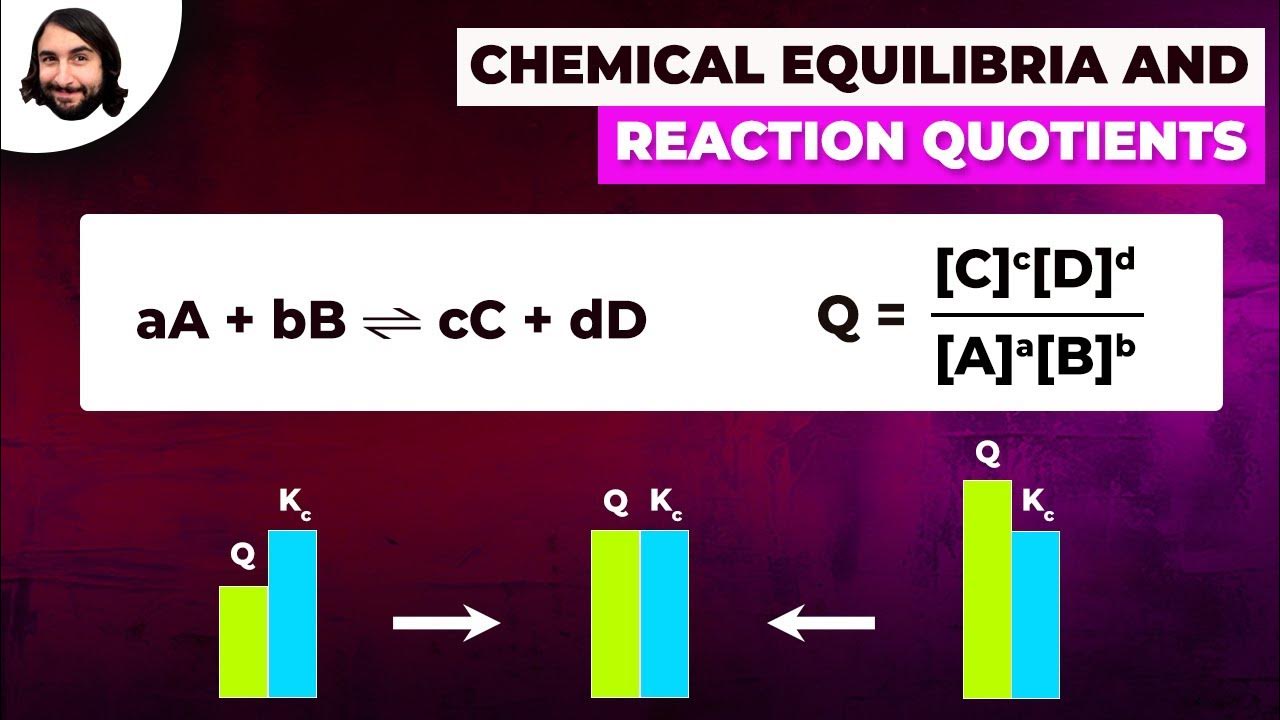2. Equilíbrio Químico: Conceito e Características (2/2) [Físico Química]
Summary
TLDRThe script explains the concept of chemical equilibrium, focusing on how concentrations and reaction rates evolve over time. It describes how reactions proceed, with products forming and reagents being consumed, until equilibrium is reached. At equilibrium, concentrations remain constant. The transcript also introduces graphical representations of concentration and reaction rate versus time, illustrating how the concentration of reactants and products change until they stabilize. Key concepts include the relationship between the rate of forward and reverse reactions and how equilibrium can shift depending on the system’s conditions, like favoring the formation of products or reactants.
Takeaways
- 😀 Equilibrium is reached spontaneously when concentrations of reactants and products become constant.
- 😀 At the beginning of a reaction, no products are present, and the reactants are consumed to form products.
- 😀 The concentration of products increases, while the concentration of reactants decreases as the reaction progresses.
- 😀 At equilibrium, the forward and reverse reaction rates are equal, meaning no net change in concentrations occurs.
- 😀 Graphs of concentration over time show how reactant and product concentrations change until equilibrium is reached.
- 😀 The time at which the concentrations stop changing marks the point of equilibrium in a reaction.
- 😀 Different reactions may reach equilibrium with different ratios of products to reactants.
- 😀 Some reactions favor the production of products, while others favor the presence of reactants at equilibrium.
- 😀 The velocity of the reaction also changes over time, with the speed of product formation increasing as reactants are consumed.
- 😀 At equilibrium, the reaction rates of both the forward and reverse reactions become equal, maintaining constant concentrations of products and reactants.
- 😀 Understanding the concentration and rate graphs is crucial to analyzing equilibrium behavior in chemical reactions.
Q & A
What is equilibrium in the context of chemical reactions?
-Equilibrium refers to the point in a chemical reaction where the rates of the forward and reverse reactions are equal, resulting in no net change in the concentrations of reactants and products.
How do concentrations of reactants and products behave at equilibrium?
-At equilibrium, the concentrations of reactants and products become constant, meaning that they no longer change over time despite the ongoing nature of both the forward and reverse reactions.
What does the graph of concentration versus time look like during a reaction reaching equilibrium?
-The graph starts with reactants being converted into products, with the concentrations of reactants decreasing and products increasing over time. Eventually, both concentrations stabilize, indicating equilibrium has been reached.
What does it mean when the concentrations of reactants and products are equal at equilibrium?
-When the concentrations of reactants and products are equal, the system is in a specific type of equilibrium where neither side is favored. This indicates a balanced system where the rates of the forward and reverse reactions are equal.
Can equilibrium be reached with different ratios of products to reactants?
-Yes, the position of equilibrium can vary, with some reactions favoring the production of more products and others favoring the formation of more reactants. Each equilibrium has its own characteristic balance.
How do reaction rates change as a system approaches equilibrium?
-As the reaction progresses, the rate of the forward reaction slows down as reactants are consumed, while the rate of the reverse reaction increases as products are formed. At equilibrium, the rates of both reactions become equal.
What is the significance of the 'equilibrium time' in a reaction?
-The equilibrium time is the moment at which the concentrations of reactants and products stop changing. It marks the point where the system has reached equilibrium and is in a stable state.
What is the relationship between reaction rate and concentration in chemical reactions?
-The reaction rate is typically proportional to the concentration of reactants. A higher concentration of reactants leads to a faster reaction rate, while as the reaction progresses, the concentration of reactants decreases, slowing the rate.
How does the velocity of the reaction change over time as the system approaches equilibrium?
-Initially, the velocity of the reaction is at its maximum because the concentration of reactants is highest. As reactants are consumed and products are formed, the rate of the forward reaction decreases, while the reverse reaction rate increases until both rates are equal at equilibrium.
What happens to the reaction rate when equilibrium is reached?
-At equilibrium, the rate of the forward reaction equals the rate of the reverse reaction, meaning the overall reaction rate becomes constant, and the concentrations of reactants and products remain unchanged.
Outlines

このセクションは有料ユーザー限定です。 アクセスするには、アップグレードをお願いします。
今すぐアップグレードMindmap

このセクションは有料ユーザー限定です。 アクセスするには、アップグレードをお願いします。
今すぐアップグレードKeywords

このセクションは有料ユーザー限定です。 アクセスするには、アップグレードをお願いします。
今すぐアップグレードHighlights

このセクションは有料ユーザー限定です。 アクセスするには、アップグレードをお願いします。
今すぐアップグレードTranscripts

このセクションは有料ユーザー限定です。 アクセスするには、アップグレードをお願いします。
今すぐアップグレード関連動画をさらに表示

Equilibrio Químico Teoría 2: Constante de equilibrio Kc. Ley de acción de masas.

Chemical Equilibria and Reaction Quotients

1. Equilíbrio Químico: Conceito e Características (1/2) [Físico Química]

1º ¿Cómo se produce una reacción química?

Konsep Laju Reaksi Kimia Kelas 11

Kesetimbangan Kimia| Kimia SMA | Tetty Afianti
5.0 / 5 (0 votes)
